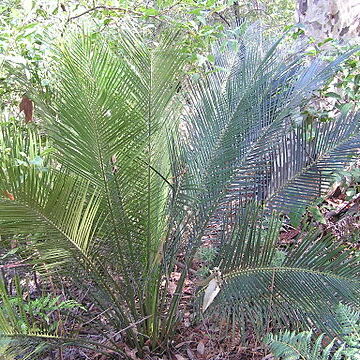Plants acaulescent, rarely caulescent; stem 0-1.5 m tall, 40-90 cm diam.; 50-150 leaves in crown. Leaves 140-250 cm long, flat (not keeled) in section, with 70-150 pinnae, dark green, semi-glossy; petiole 12-40 cm long, 10-16 mm wide at lowest pinna. Basal pinnae reducing to spines. Median pinnae simple, 16-36 cm long, 8-13 mm wide, strongly discolorous; margins flat; apex entire, spinescent. Pollen cones narrowly ovoid to fusiform, 25-45 cm long, 8-12 cm diam.; microsporophyll lamina 20-40 mm long, 15-25 mm wide; apical spine 5-50 mm long. Seed cones ovoid, 20-45 cm long, 10-20 cm diam.; megasporophyll with an expanded, peltate apex 30-85 mm wide and 15-43 mm long; apical spine 8-80 mm long. Seeds flattened-ovoid, 30-45 mm long, 20-30 mm wide; sarcotesta red.


